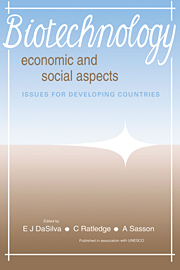Book contents
- Frontmatter
- Contents
- List of contributors
- Preface
- 1 Biotechnology: the socio-economic revolution? A synoptic view of the world status of biotechnology
- 2 Bioethanol production: economic and social considerations in failures and successes
- 3 Biofertilizers: agronomic and environmental impacts and economics
- 4 Microalgal biotechnology: is it an economic success?
- 5 Production of useful biochemicals by higher-plant cell cultures: biotechnological and economic aspects
- 6 Mushroom production – an economic measure in maintenance of food security
- 7 The economic viability of Single Cell Protein (SCP) production in the twenty-first century
- 8 The impact of biotechnology on international commodity trade
- 9 Biotechnology: socio-economic considerations, intercultural perspectives and international viewpoints
- 10 Joint microbial biotechnological ventures in developing countries: social promises and economic considerations
- 11 The economic and social implications of gene technology to developing countries
- 12 Making biotechnology appropriate – and environmentally sound
- 13 Information support for research and development in biotechnological applications
- 14 The effects of emerging biotechnologies on plant and animal agriculture – a viewpoint
- Index
7 - The economic viability of Single Cell Protein (SCP) production in the twenty-first century
Published online by Cambridge University Press: 04 August 2010
- Frontmatter
- Contents
- List of contributors
- Preface
- 1 Biotechnology: the socio-economic revolution? A synoptic view of the world status of biotechnology
- 2 Bioethanol production: economic and social considerations in failures and successes
- 3 Biofertilizers: agronomic and environmental impacts and economics
- 4 Microalgal biotechnology: is it an economic success?
- 5 Production of useful biochemicals by higher-plant cell cultures: biotechnological and economic aspects
- 6 Mushroom production – an economic measure in maintenance of food security
- 7 The economic viability of Single Cell Protein (SCP) production in the twenty-first century
- 8 The impact of biotechnology on international commodity trade
- 9 Biotechnology: socio-economic considerations, intercultural perspectives and international viewpoints
- 10 Joint microbial biotechnological ventures in developing countries: social promises and economic considerations
- 11 The economic and social implications of gene technology to developing countries
- 12 Making biotechnology appropriate – and environmentally sound
- 13 Information support for research and development in biotechnological applications
- 14 The effects of emerging biotechnologies on plant and animal agriculture – a viewpoint
- Index
Summary
Introduction
The use of microorganisms as a protein source in human foods and animal feeds has long been established. In the early days, microorganisms played an important role in producing fermented foods, such as bread, cheese, wine, yogurt and other useful compounds. Single Cell Protein (SCP) has been under active investigation for more than 30 years, as an ingredient in animal feeds, and yeast protein has been used in varying degrees in foods and fodder. There was a great expectation that the microbial conversion of hydrocarbons to protein would satisfy the future needs of an expanding world population. After the 1973 oil crisis, this expectation changed, and further development of SCP technology was discouraged in many Western countries. In oilproducing countries, however, SCP technology still holds an attraction as part of an integrated food/fodder production system for egg, poultry, veal and fish production.
The term ‘Single Cell Protein’ (SCP) was coined by C.L. Wilson in 1966, and has been used widely since that time in referring to microbial cells grown in large industrial systems as a protein source for food and feed applications (Scrimshaw, 1968). However, this term refers to a whole microbial biomass, i.e. to a complex mixture of proteins, nucleic acids, carbohydrates, lipids, minerals, vitamins and other cell constituents. Furthermore, the term SCP applies not only to single-cell organisms, such as yeast, bacteria and unicellular algae, but also to coenocytic multicellular moulds.
- Type
- Chapter
- Information
- Biotechnology: Economic and Social AspectsIssues for Developing Countries, pp. 142 - 164Publisher: Cambridge University PressPrint publication year: 1992
- 2
- Cited by



